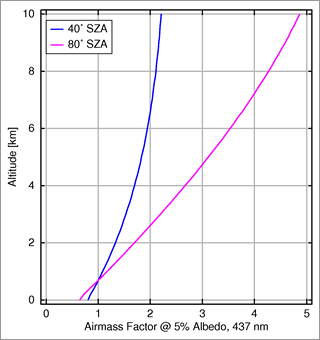The sensitivity of the satellite measurement depends on the altitude where the NO2 is located. Over dark surfaces a particular number of NO2 molecules at an altitude of 15 km produces a larger slant column value than the same number in the lowest kilometre in the atmosphere. As already briefly mentioned in section xxx [figure with scattering], the reason for this behaviour is that some photons are scattered before they reach the surface and therefore do not 'see' the NO2 that is closer to the ground.
In general, for a dark surface, the sensitivity (and thus the airmass factor) decreases from the stratosphere down to the ground. The effect is largest over the lowest 1..2 kilometres.
The amount by which the airmass factor decreases with altitude also depends on the solar position; the lower the sun, the lower the signal. At twilight, when the sensitivity in the stratosphere is a maximum, no direct light reaches the surface and measurements are 'blind' to the boundary layer.

Fig 3.4.3.2.1:
Image: AT2-ELS
In conclusion, a good estimate of the vertical NO2 distribution within the troposphere is needed to arrive at reliable airmass factors for the retrieval. It is important to note that only the relative distribution, not the absolute amount of the NO2 is required. This information is usually taken from three-dimensional chemical model simulations which take into account all our knowledge of emissions, dynamics and chemistry.